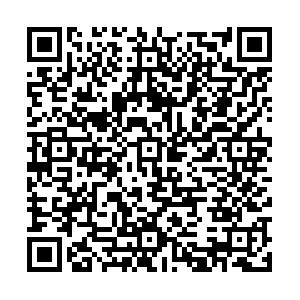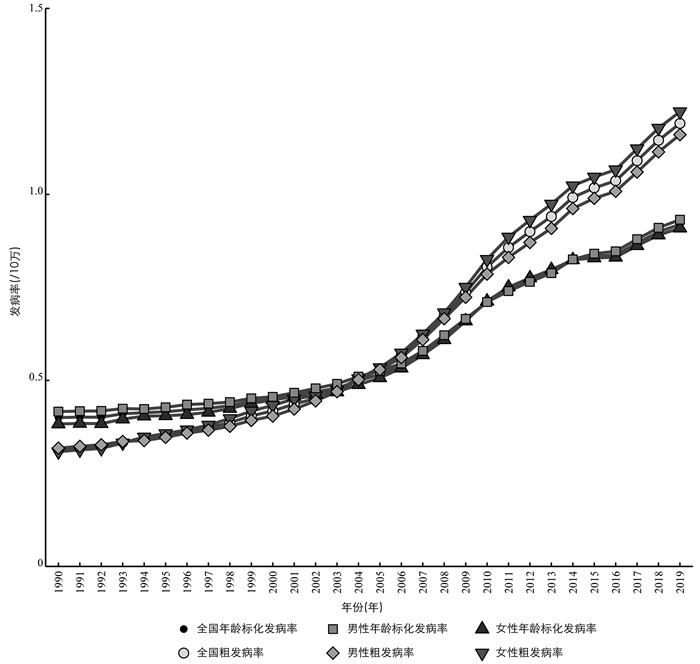Analysis of secular trends in incidence of skin cancer in China based on Joinpoint regression and age-period-cohort model
-
摘要:
目的 分析中国皮肤癌的发病趋势并分别估计其年龄、时期、队列效应。 方法 从2019年全球疾病负担研究中估计中国皮肤癌发病率的变化趋势。采用Joinpoint回归分析模型分析年度变化百分比和平均年度变化百分比(average annual percentage change, AAPC);利用年龄-时期-队列模型评估年龄、时期和出生队列效应对皮肤癌发病率的影响。 结果 1990―2019年中国皮肤癌男性和女性年龄标准化发病率均上升。Joinpoint回归分析模型分析显示皮肤恶性黑色素瘤男性AAPC为2.8%(95% CI: 2.6~3.0),女性AAPC为3.0%(95% CI: 2.8~3.2);基底细胞癌男性AAPC为4.2%(95% CI: 3.9~4.4),女性AAPC为4.0%(95% CI: 3.7~4.3);鳞状细胞癌男性AAPC为3.7%(95% CI: 3.5~3.9),女性AAPC为2.9%(95% CI: 2.7~3.0)。此外,年龄-时期-队列模型表明无论男女,皮肤癌的发病风险均随年龄增长和年份推移而增加,且较晚出生的队列的发病风险均低于之前出生的队列。 结论 1990―2019年中国皮肤癌的发病率呈上升趋势,年龄越大、出生越早且生活在当代的人其发病风险更高。应重视皮肤癌的防治工作。 -
关键词:
- 皮肤癌 /
- 发病率 /
- Joinpoint回归分析 /
- 年龄-时期-队列模型
Abstract:Objective To analyze the incidence trends of skin cancer in China and to estimate age, period, and cohort effects. Methods We assessed incidence trends of skin cancer in China based on the Global Burden of Disease, Injuries, and Risk Factors Study 2019. Joinpoint regression analysis was used to calculate the annual percentage change and average annual percentage change (AAPC). Age-period-cohort model was used to explore the age effect, period effect, and cohort effect of skin cancer. Results Age-standardized incidence rate of skin cancer among males and females increased significantly in China from 1990 to 2019. Joinpoint regression indicated that AAPC of malignant skin melanoma in males was 2.8% (95% CI: 2.6-3.0) and in females was 3.0% (95% CI: 2.8-3.2); AAPC of basal cell carcinoma in males was 4.2% (95% CI: 3.9-4.4) and in females was 4.0% (95% CI: 3.7-4.3); AAPC of squamous cell carcinoma in males was 3.7% (95% CI: 3.5-3.9) and in females was 2.9% (95% CI: 2.7-3.0). For both males and females, the relative risk of skin cancer incidence increased with advancing age and time period, but decreased from earlier birth cohorts to more recent birth cohorts. Conclusions The incidence of skin cancer shows an increasing trend from 1990 to 2019. People who born earlier, being older, and living in modern times have a higher risk of skin cancer incidence. Control and treatment of skin cancer should be paid attention to. -
Key words:
- Skin cancer /
- Incidence /
- Joinpoint regression analysis /
- Age-period-cohort model
-
表 1 1990―2019年中国皮肤癌年龄标准化发病率的变化趋势
Table 1. Trends of age-standardized incidence rate of skin cancer in China from 1990 to 2019
皮肤癌类型 全国 男性 女性 年份(年) APC(%, 95% CI)值 年份(年) APC(%, 95% CI)值 年份(年) APC(%, 95% CI)值 MSM 区间 1990―1997 0.9 (0.7~1.2) a 1990―1995 0.5 (0.2~0.9) a 1990―1997 1.3 (0.9~1.6) a 1998―2003 2.1 (1.6~2.5) a 1996―2001 1.4 (1.0~1.8) a 1998―2005 2.3 (1.9~2.7) a 2004―2006 3.9 (1.7~6.1) a 2002―2006 3.2 (2.7~3.8) a 2006―2011 7.2 (6.6~7.9) a 2007―2011 7.0 (6.3~7.7) a 2007―2010 7.0 (6.1~7.9) a 2012―2019 2.3 (2.0~2.6) a 2012―2019 2.5 (2.3~2.7) a 2011―2014 3.5 (2.6~4.4) a 2015―2019 2.6 (2.2~3.0) a AAPC (95% CI)值 2.9 (2.7~3.2) a 2.8 (2.6~3.0) a 3.0 (2.8~3.2) a BCC 区间 1990―1995 -2.3(-2.9~-1.8) a 1990―1995 -2.2(-2.7~-1.7) a 1990―1995 -2.4(-3.0~-1.9) a 1996―1999 17.9(16.4~19.3)a 1996―1999 18.4(17.0~19.8) a 1996―1999 17.5(16.1~19.0) a 2000―2011 1.4(1.2~1.5) a 2000―2011 1.3(1.1~1.5) a 2000―2011 1.4(1.2~1.5) a 2012―2017 4.1(3.5~4.7) a 2012―2017 4.1(3.6~4.7) a 2012―2017 4.1(3.5~4.7) a 2018―2019 11.3(8.7~14.1) a 2018―2019 11.6(8.9~14.2) a 2018―2019 11.1(8.4~13.9) a AAPC(95% CI)值 4.1(3.8~4.3) a 4.2(3.9~4.4) a 4.0(3.7~4.3) a SCC 区间 1990―1993 0.4(-0.2~1.0) 1990―1993 -0.1(-0.7~0.6) 1990―1993 0.7(0.3~1.1) a 1994―1996 2.3(1.1~3.4) a 1994―1996 2.3(1.0~3.7) a 1994―1996 2.1(1.3~2.9) a 1997―1999 7.9(6.7~9.2) a 1997―1999 9.5(8.1~11.0) a 1997―1999 5.3(4.5~6.1) a 2000―2010 2.2(2.1~2.2) a 2000―2010 2.2(2.1~2.4) a 2000―2009 2.0(1.9~2.1) a 2011―2017 3.9(3.7~4.1) a 2011―2017 4.2(4.0~4.4) a 2010―2017 3.3(3.2~3.4) a 2018―2019 8.2(7.0~9.5) a 2018―2019 9.2(7.8~10.6) a 2018―2019 6.4(5.6~7.3) a AAPC(95% CI)值 3.4(3.2~3.6) a 3.7(3.5~3.9) a 2.9(2.7~3.0) a 注:a表示P<0.05。 表 2 中国皮肤癌发病率年龄-时期-队列模型分析结果
Table 2. Age-period-cohort model analysis results of skin cancer incidence in China
效应系数 MSM BCC SCC 男性 女性 男性 女性 男性 女性 年龄(岁) 0~<5 -1.56 -1.54 5~ < 10 -1.85 -1.67 10~ < 15 -2.05 -1.93 15~ < 20 -0.95 -0.79 20~ < 25 -0.82 -0.56 -1.50 a -1.54 a -2.18 -2.78 25~ < 30 -0.61 -0.22 -1.42 a -1.36 a -2.06 -2.72 30~ < 35 0.16 0.08 -1.21 a -1.05 a -1.49 -1.65 35~ < 40 0.45 0.14 -0.98 a -0.71 a -0.98 -0.92 40~ < 45 0.74 0.34 -0.65 a -0.37 a -0.67 -0.10 45~ < 50 0.47 0.40 -0.34 -0.05 -0.43 0.49 50~ < 55 0.80 0.59 0.03 0.22 0.02 0.58 55~ < 60 1.02 a 0.66 0.36 a 0.44 a 0.45 0.40 60~ < 65 0.51 0.59 0.70 a 0.64 a 0.91 a 0.71 65~ < 70 0.71 0.67 1.00 a 0.81 a 1.29 a 1.14 70~ < 75 0.84 a 0.88 a 1.21 a 0.93 a 1.50 a 1.35 a 75~ < 80 0.96 a 1.09 a 1.37 a 1.00 a 1.60 a 1.44 a ≥80 1.18 a 1.28 a 1.43 a 1.05 a 2.03 a 2.07 a 时期(年) 1990―1994 -0.59 -0.58 -0.82 a -0.80 a -0.81 a -0.77 a 1995―1999 -0.41 -0.44 -0.40 a -0.40 a -0.46 a -0.43 2000―2004 -0.19 -0.22 0.07 0.05 -0.07 -0.11 2005―2009 0.08 a 0.09 0.17 a 0.17 a 0.15 0.15 2010―2014 0.44 0.48 0.34 a 0.34 a 0.42 a 0.43 2015―2019 0.67 0.67 a 0.64 a 0.63 a 0.77 a 0.73 a 队列(年) 1910―1914 1.15 1.02 0.76 a 0.90 a 1.21 a 1.40 1915―1919 1.00 0.88 0.61 a 0.65 a 0.96 a 1.09 1920―1924 0.85 0.74 0.51 a 0.46 a 0.76 a 0.84 1925―1929 0.65 0.64 0.45 a 0.35 a 0.63 a 0.68 1930―1934 0.58 0.54 0.39 a 0.25 a 0.49 a 0.51 1935―1939 0.45 0.42 0.33 a 0.17 0.34 0.34 1940―1944 0.28 0.28 0.32 a 0.15 0.23 0.22 1945―1949 0.18 0.17 0.27 a 0.10 0.12 0.07 1950―1954 0.06 0.10 0.21 0.04 0.05 -0.03 1955―1959 -0.05 -0.01 0.14 -0.01 0.01 -0.11 1960―1964 -0.16 -0.11 0.04 -0.06 -0.04 -0.18 1965―1969 -0.24 -0.17 -0.07 -0.08 -0.17 -0.26 1970―1974 -0.30 -0.25 -0.22 -0.14 -0.35 -0.33 1975―1979 -0.33 -0.31 -0.39 -0.24 -0.48 -0.43 1980―1984 -0.30 -0.35 -0.60 -0.40 -0.66 -0.57 1985―1989 -0.31 -0.43 -0.77 -0.55 -0.84 -0.77 1990―1994 -0.39 -0.46 -0.92 -0.72 -1.03 -1.11 1995―1999 -0.48 -0.46 -1.05 -0.87 -1.23 -1.35 2000―2004 -0.59 -0.50 2005―2009 -0.57 -0.50 2010―2014 -0.65 -0.57 2015―2019 -0.82 -0.66 AIC 2.41 2.42 4.98 4.95 3.36 2.93 BIC -277.39 -277.38 -188.18 -189.99 -191.44 -191.58 偏差 0.10 0.12 3.52 1.71 0.25 0.11 对数似然比 -81.02 -81.62 -160.41 -158.84 -97.04 -80.46 注:a 表示P<0.05。 -
[1] Surdu S. Non-melanoma skin cancer: occupational risk from UV light and arsenic exposure[J]. Rev Environ Health, 2014, 29(3): 255-264. DOI: 10.1515/reveh-2014-0040. [2] Fijałkowska M, Koziej M, Antoszewski B. Detailed head localization and incidence of skin cancers[J]. Sci Rep, 2021, 11(1): 12391. DOI: 10.1038/s41598-021-91942-5. [3] Leiter U, Keim U, Garbe C. Epidemiology of skin cancer: update 2019[J]. Adv Exp Med Biol, 2020, 1268: 123-139. DOI: 10.1007/978-3-030-46227-7_6. [4] Carr S, Smith C, Wernberg J. Epidemiology and risk factors of melanoma[J]. Surg Clin North Am, 2020, 100(1): 1-12. DOI: 10.1016/j.suc.2019.09.005. [5] 中华医学会皮肤性病学分会皮肤肿瘤研究中心, 中国医师协会皮肤科医师分会皮肤肿瘤学组. 皮肤基底细胞癌诊疗专家共识(2021)[J]. 中华皮肤科杂志, 2021, 54(9): 757-764. DOI: 10.35541/cjd.20201139.Skin Tumor Research Center, Chinese Society of Dermatology, Subcommittee on Skin Tumor, China Dermatologist Association. Expert consensus on diagnosis and treatment of cutaneous basal cell carcinoma(2021)[J]. Chin J Dermatol, 2021, 54(9): 757-764. DOI: 10.35541/cjd.20201139. [6] Wu Y, Wang Y, Wang L, et al. Burden of melanoma in China, 1990-2017: findings from the 2017 Global Burden of Disease Study[J]. Int J Cancer, 2020, 147(3): 692-701. DOI: 10.1002/ijc.32764. [7] 徐莉莉, 张丽成, 田雪, 等. 中国皮肤癌住院患者流行病学的研究[J]. 中国循证医学杂志, 2020, 20(11): 1280-1283. DOI: 10.7507/1672-2531.202007025.Xu LL, Zhang LC, Tian X, et al. Epidemiological research on inpatients with skin cancer in China[J]. Chin J Evid-Based Med, 2020, 20(11): 1280-1283. DOI: 10.7507/1672-2531.202007025. [8] Zhang W, Zeng W, Jiang A, et al. Global, regional and national incidence, mortality and disability-adjusted life-years of skin cancers and trend analysis from 1990 to 2019: an analysis of the Global Burden of Disease Study 2019[J]. Cancer Med, 2021, 10(14): 4905-4922. DOI: 10.1002/cam4.4046. [9] Laughter MR, Maymone MBC, Karimkhani C, et al. The burden of skin and subcutaneous diseases in the united states from 1990 to 2017[J]. JAMA Dermatol, 2020, 156(8): 874-881. DOI: 10.1001/jamadermatol.2020.1573. [10] GBD 2019 Diseases and Injuries Collaborators. Global burden of 369 diseases and injuries in 204 countries and territories, 1990-2019: a systematic analysis for the Global Burden of Disease Study 2019[J]. Lancet, 2020, 396(10258): 1204-1222. DOI: 10.1016/S0140-6736(20)30925-9. [11] Wang L, Yu C, Liu Y, et al. Lung cancer mortality trends in China from 1988 to 2013: new challenges and opportunities for the government[J]. Int J Environ Res Public Health, 2016, 13(11): e1052. DOI: 10.3390/ijerph13111052. [12] Liu X, Jiang J, Yu C, et al. Secular trends in incidence and mortality of bladder cancer in China, 1990-2017: a joinpoint and age-period-cohort analysis[J]. Cancer Epidemiol, 2019, 61: 95-103. DOI: 10.1016/j.canep.2019.05.011. [13] Schierbeck J, Vestergaard T, Bygum A. Skin cancer associated genodermatoses: a literature review[J]. Acta Derm Venereol, 2019, 99(4): 360-369. DOI: 10.2340/00015555-3123. [14] LaBerge GS, Duvall E, Grasmick Z, et al. Recent advances in studies of skin color and skin cancer[J]. Yale J Biol Med, 2020, 93(1): 69-80. [15] Pil L, Hoorens I, Vossaert K, et al. Burden of skin cancer in Belgium and cost-effectiveness of primary prevention by reducing ultraviolet exposure[J]. Prev Med, 2016, 93: 177-182. DOI: 10.1016/j.ypmed.2016.10.005. [16] Lucas RM, Yazar S, Young AR, et al. Human health in relation to exposure to solar ultraviolet radiation under changing stratospheric ozone and climate[J]. Photochem Photobiol Sci, 2019, 18(3): 641-680. DOI: 10.1039/c8pp90060d. [17] Aggarwal P, Knabel P, Fleischer AB. United States burden of melanoma and non-melanoma skin cancer from 1990 to 2019[J]. J Am Acad Dermatol, 2021, 85(2): 388-395. DOI: 10.1016/j.jaad.2021.03.109. [18] 周楚, 文龙, 王佩茹, 等. 光声成像在皮肤肿瘤中的应用进展[J]. 中华皮肤科杂志, 2021, 54(3): 256-259. DOI: 10.35541/cjd.20190884.Zhou C, Wen L, Wang PR, et al. Application of photoacoustic imaging in the diagnosis and treatment of skin tumors[J]. Chin J Dermatol, 2021, 54(3): 256-259. DOI: 10.35541/cjd.20190884. [19] Pil L, Hoorens I, Vossaert K, et al. Cost-effectiveness and budget effect analysis of a population-based skin cancer screening[J]. JAMA Dermatol, 2017, 153(2): 147-153. DOI: 10.1001/jamadermatol.2016.4518. [20] Madheswaran S, Mungra N, Biteghe FAN, et al. Antibody-based targeted interventions for the siagnosis and treatment of skin cancers[J]. Anticancer Agents Med Chem, 2021, 21(2): 162-186. DOI: 10.2174/1871520620666200728123006. [21] 严月华, 吴剑波, 王兴刚, 等. 武汉市交通警察紫外线职业性危害及防晒意识和行为调查[J]. 中华劳动卫生职业病杂志, 2010, 28(11): 831-834. DOI: 10.3760/cma.j.issn.1001-9391.2010.11.008.Yan YH, Wu JB, Wang XG, et al. Investigation on occupational hazards of ultraviolet light, sunscreen awareness and behaviors in Wuhan city traffic police[J]. Chin J Ind Hyg Occup Dis, 2010, 28(11): 831-834. DOI: 10.3760/cma.j.issn.1001-9391.2010.11.008. -





 下载:
下载:






